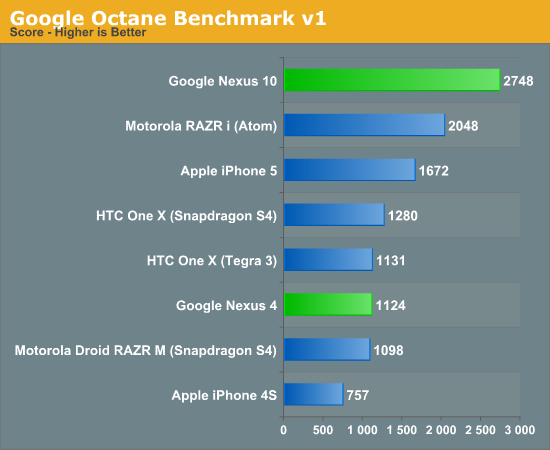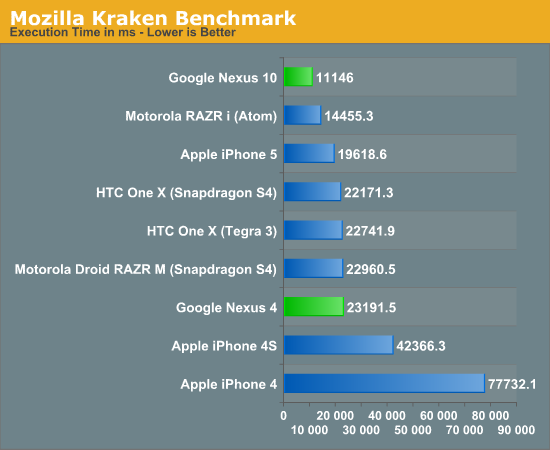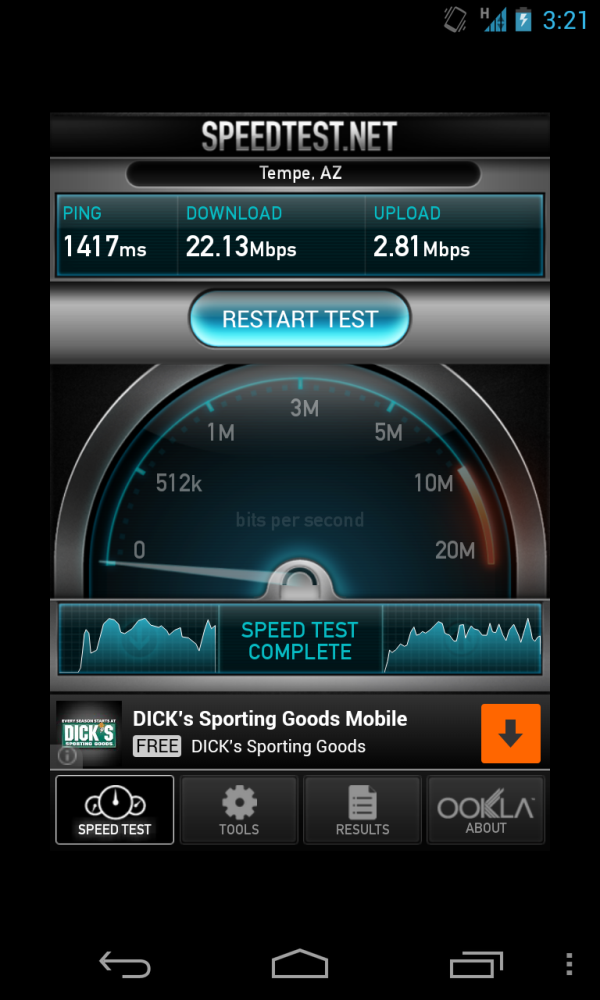Google Nexus 4 and Nexus 10 Performance Preview
by Anand Lal Shimpi & Brian Klug on November 2, 2012 11:00 AM ESTEarlier this week Google announced two new flagship Nexus devices: the Nexus 4 smartphone and the Nexus 10 tablet. We received review samples of both earlier this week, and while we're hard at work at full reviews of the devices we couldn't help but share all of the test data we've been able to amass at this point.
For those who aren't familiar with it, the Nexus 4 features Qualcomm's Snapdragon S4 Pro SoC - a quad-core 28nm Krait CPU with Qualcomm's next-generation Adreno 320 GPU. The combination proved quite formidable in the MDP/T we tested, as well as LG's recently announced Optimus G. The SoC drives a 4.7-inch 1280 x 768 IPS display and is paired with 2GB of LPDDR2 memory. The Nexus 4 ships unlocked with 8GB of NAND for $299 without a contract ($349 for the 16GB version). Pair that with DC-HSPA+ support and you get an absolute killer smartphone for use on T-Mobile: no contracts, very low monthly fees, and compelling cellular performance:
Brian will talk more about the combination in his full review, but rest assured that the lack of LTE is workable depending on T-Mobile coverage where you live/travel to.
The Nexus 10 also boasts a brand new SoC: Samsung's Exynos 5 Dual. The Exynos 5 Dual features two ARM Cortex A15 cores running at 1.7GHz as well as ARM's own Mali-T604 GPU. This happens to be the exact same platform used in the new Chromebook, just running Android. The Nexus 10 features a 10.1-inch 2560 x 1600 display, giving it the same resolution as the 13-inch MacBook Pro with Retina Display - but in an even smaller form factor. Google is also aggressive on Nexus 10 pricing: the 16GB WiFi-only tablet sells for $399, with the 32GB version going for $499.
Both Nexus devices run Android 4.2 and are guaranteed to be the first devices to be updated to upcoming Android revisions for the foreseeable future (it's the power of Nexus).
We haven't had a ton of time to test the devices and put this together so you're going to see combined performance charts throughout the rest of this article.
CPU Performance
The big story when it comes to CPU performance is a look at how the Cortex A15s perform under Android. Unfortunately we're still left with mostly browser based benchmarks to measure CPU performance, which actually highlights a major issue in our testing: Android V8 optimization doesn't seem to be anywhere near as good as it is under Chrome OS or Windows. As a result, all of the Nexus 10 performance scores end up slower than the new Chromebook - despite using the same SoC and running Chrome on both platforms. It's also possible that the Exynos 5 Dual in the Chromebook is allowed to burn a bit more power, translating to better performance, but either way the solution here in the Nexus 10 doesn't look as good across the board.

SunSpider performance is good, but not significantly better than Qualcomm's Krait based Snapdragon S4. Both the iPhone 5 and RAZR i are able to outperform the Nexus 10. The S4 Pro based Nexus 4 tends to be in line with other S4 based devices - SunSpider doesn't really give much credit to the extra 2 cores.

BrowserMark puts the Nexus 10 behind many platforms that should be faster, I'm even wondering here if there's some hard partitioning of memory bandwidth between the CPU and GPU to drive the 2560 x 1600 display that's simply choking the CPU here.
The Nexus 4 does ok, but again there seem to be some V8 optimization issues at work here under Android 4.2. At 1.5GHz it should deliver at least the performance of the dual-core Snapdragon S4 solutions.

Octane is the first test where the Cortex A15s are really able to flex their muscle - the Exynos 5 Dual based Nexus 10 manages to outperform the RAZR i by 34%, and compared to the A6/Swift based iPhone 5 the advantage grows to 64%.
The Nexus 4 performs about in line with other Snapdragon S4 based devices, although once again the extra 2 cores don't seem to be doing much for it here at all.

Kraken also paints the Cortex A15 based Nexus 10 in a good light: there's a 30% advantage over the RAZR i and a 76% advantage over the iPhone 5. These numbers will shrink a bit compared to other tablets, but not by much. The Nexus 4, once again, ends up performing similarly to dual-core Snapdragon S4 based devices.
Overall, the Nexus 10 results show us some real promise for what we can expect from ARM Cortex A15 based SoCs. The potential upside to this new architecture is huge.

















244 Comments
View All Comments
medi01 - Saturday, November 3, 2012 - link
No SD card slot eh?Let me guess, "it's confusing".
No thanks, dear google.
will2 - Saturday, November 3, 2012 - link
Anand and teamI think your preview was useful in drawing attention to certain problems that need to be tackled in the full review.
I would like to ask that you heed 5 things in the full review;
1) It is good that you include a few older phones/tablets in your comparison with the 2 under review to give a historical perspective, but I think your table devotes too much space to some fairly obscure old models at expense of alternative buys to the 2 under review. Surely any comparative review should include all NEW flagship phones that people might buy as an alternative to those under review. You included the new LG Optimus G, in only a few graphs which left a very incomplete comparison. The SG3 has been updated to JB4.1 which gives different results but your graph does not tell you which you are comparing.
2) You have identified some big performance variations between the LG Optimus G and LG N4, indicating there may be design issues that need to be quickly fixed. They need to be fully investigated and Google's and LG's response to them, with a timescale to fixing the problem.
3) You identified unexplained performance differences between the 2 A15 based devices (N10 & Chromebook). They also need to be fully investigated and aired.
4) A number of posts suggest the Chrome Browser is not a useful benchmark. Need to carefully choose which benchmarks are used for the full review, to give the clearest objective picture.
5) I know your past full reviews have given detailed WiFi speed/distance benchmarks, so I trust your full review will include them, and also for the BT4, and a good test of the new Miracast wireless TV connection.
If Google/LG/Samsung are not able to fix the design issues quickly, I think it would be better that your full review is not released until they are, and perhaps publish an updated preview if the delay is long.
nickfer - Saturday, November 3, 2012 - link
Excellent suggestions. I would add:1. Please, please say what version of Android you are testing for each phone. When available, test multiple versions (say ICS and JB). I find this more important than testing very different phones. It's good to keep track of the software evolution, mostly when it involves very different kernels.
2. Be scientific. Select a number of phones you want to test and be consistent with it. Don't test some phones on some benchmarks on others. It's totally useless.
3. Test different browsers. You got Chrome and Firefox on Android. Test them both, at least that would tell if the performance hits are due to the software being tested or the hardware (at least to some extent).
cain_templar - Saturday, November 3, 2012 - link
The top / average / median numbers of Nexus 4 are way better on GLBenchmark website than your results.http://www.glbenchmark.com/phonedetails.jsp?D=Goog...
wymiata3 - Sunday, November 4, 2012 - link
Why wasn't this addressed? Apart from using a different operating system I believe the webkit should be pretty much the same, yet we see 1300ish ms vs. 650ish ms results.Jorange - Sunday, November 4, 2012 - link
Chrome OS in no doubt on a much newer version of webkit / V8. On the desktop going from version 18 to 19, brought a 25% improvement in sunspider scores alone.Specialist79 - Sunday, November 4, 2012 - link
Has the battery benchmark been performed with the same browser on all Android devices?Freedomuser - Sunday, November 4, 2012 - link
You guys rock! Very reliable reviews. Keep up the good work.Holy madness - Sunday, November 4, 2012 - link
In the 3G/4G battery performance chart, the iPhone 5 appears twice. In the tablet comparison, there is an "iPad 2.4". What is this? Make sure your tables are accurate before you post them or you lose all credibility.As a complete aside, I upgraded from an iPhone 4 to an iPhone 5 and while the 5 gets about 8 hours of 4G battery life, there is no way the 4 got anywhere near as poor as 3.5 hours. It got 8, too. Very suspicious.
thesavvymage - Sunday, November 4, 2012 - link
The iPad 2,4 is the 4th iteration of the iPad 2, the one with the 32nm processor shrink. Not a typo. This is one of the most reputable tech sites out there, it'd take something big to lose credibility. Not some simple reader error